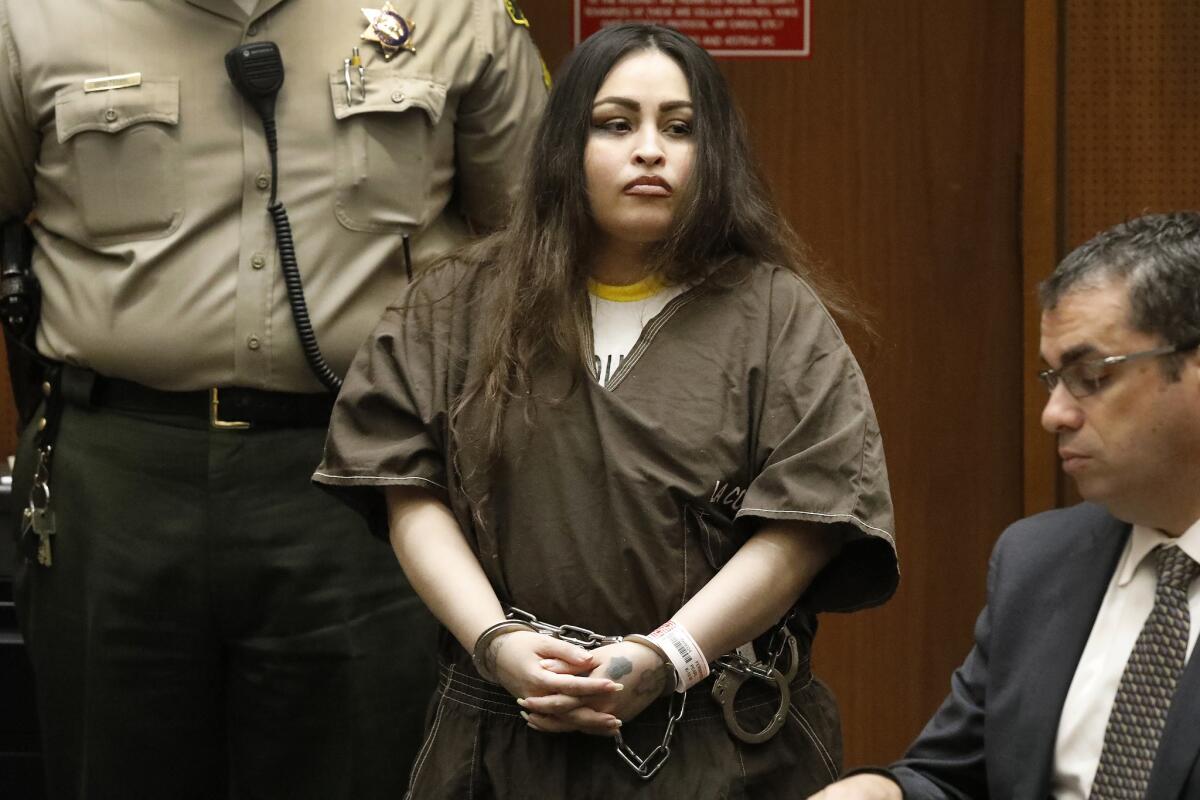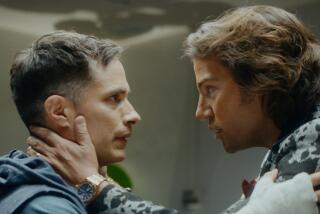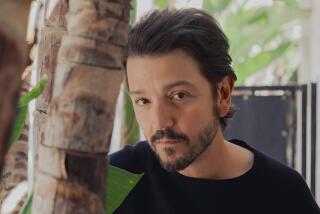Meet the journalist and director behind Netflix’s ‘The Trials of Gabriel Fernandez’

It began, as great journalism often does, with a source.
When longtime journalist Lowell Bergman recruited former Times reporter Garrett Therolf to the Investigative Reporting Program that he founded at the University of California Berkeley with the idea of turning Therolf’s work into documentaries, it seemed a “distant” notion, Therolf says.
For the record:
11:53 a.m. March 24, 2020An earlier version of this story misidentified the title of director Brian Knappenberger’s previous project. It is “Nobody Speak,” not “Nobody Speaks.”
That is, until his reporting on another subject led him to reconsider what the form could bring to the case of Gabriel Fernandez, the Palmdale 8-year-old whose abuse, torture and 2013 murder at the hands of his mother and her boyfriend exposed systemic failures within the Los Angeles County Dept. of Children and Family Services and other county departments.
“I remember I was driving in Mississippi and talking to a source on another story, and Gabriel’s story had always stuck with her,” Therolf remembers. “She planted the seed in my head that a docuseries might be a good idea for a number of reasons” — the intimacy of the camera, the importance of character and the opportunity to explore the issues raised by Gabriel’s death in even greater detail.
And so the concept for Netflix’s harrowing six-part docuseries “The Trials of Gabriel Fernandez” was born. All Therolf needed now was a director.
His Investigative Reporting Program colleague Janice Hui recommended Brian Knappenberger, the documentarian behind “The Internet’s Own Boy,” about the life and tragic death of open-internet advocate Aaron Swartz, and “Nobody Speak,” about press freedom under President Trump. Therolf flew to L.A. to persuade the filmmaker, fresh off an appearance for “Nobody Speaks” on “Late Night With Seth Meyers,” to consider the project. After Therolf introduced Knappenberger to Gregory Merritt and Darlene Starr, two of the social workers involved in Gabriel’s case, the director was sold.
“The social workers had been demonized in the press. We play some of the clips from [KFI AM 640 radio’s] ‘Gary and Shannon’ show, and that was maybe a lighter touch than some days. They really were looked at as evil here. And when you meet them, they’re anything but,” Knappenberger says. “Something clicked there. While they clearly made egregious errors … it’s also clear that it doesn’t stop with them.”
Thanks to the unusual decision by L.A. County Superior Court Judge George Lomeli to grant the production team permission to film inside the courtroom, the narrative backbone of the series is the murder trial of Isauro Aguirre, Gabriel’s mother’s boyfriend. But Therolf’s reporting, and local journalism more broadly, not only provides an entree into the story, which opens and closes on a shot of The Times’ former home in downtown Los Angeles. It is, in a sense, the hero of it.
“It’s a very challenging beat, and to a large degree, a lot of the stories [Therolf] did were just the act of his own perseverance — getting judges to let him into juvenile court, which we rarely get to do; really digging and digging and digging and getting documents to show the kind of cracks in the system that just are not publicly available,” says Shelby Grad, The Times’ deputy managing editor for California/Metro. He added that very few reporters in the U.S. cover child welfare, and even fewer do it full-time. “Journalism is one of the things that’s needed to expose these things because it’s a system involving children, involving things that are by their nature private, and so it’s very easy for people not to know.”
“The Trials of Gabriel Fernandez” not only reflects Therolf’s and others’ prior reporting, it also builds on it. As the series proceeds, the structure comes to resemble that of “The Wire,” the byzantine drama created by another former newspaper journalist, David Simon, about the life of Baltimore, which focuses on a different city institution in each of its five seasons. Gabriel’s case becomes the jumping-off point for examinations of Maximus, a third-party contractor in child welfare and other local government functions, and the use of algorithms to help social workers determine next steps for the children on their caseload — both of which have implications that reach far beyond the Fernandez family or even L.A. County.

“You’re going toward the complexity, but you also don’t want to leave viewers in a morass,” Therolf says of the documentary’s structure, pointing out that one in seven children in California, and one in three black children, are reported to the child abuse hotline before the age of 5. “You want to clarify how these systems work. ... This is something that huge segments of our community are going through all the time, yet even for the clients the system is mysterious.”
Whether the style of “The Trials of Gabriel Fernandez” is as clarifying as its journalism is more contentious. Though the series has received generally positive reviews, critics including The Times’ Robert Lloyd and Slant Magazine’s Ed Gonzalez have suggested that its score, title sequence and use of reenactments — drawing on the “true crime” aesthetic developed by “The Jinx: The Life and Deaths of Robert Durst,” “Making a Murderer” and other entries in the increasingly ubiquitous genre — might run closer to entertainment than education. While both Therolf and Knappenberger dismiss the comparison to “The Jinx,” the director acknowledges that the series plays on our expectations about “true crime.”
“What we’re doing is hijacking that to do something entirely different,” Knappenberger says, emphasizing that his ultimate interest was accuracy. “I think we’re using some similar visual style in order to draw people in, just to be kind of blunt. I also don’t think it’s that controversial anymore. We live in a maelstrom of images and different parts and fragments of stories, and I think audiences are aware of and savvy about that stuff.”
Therolf compares the reenactments in “The Trials of Gabriel Fernandez” to The Times’ use of an artist’s renderings in its coverage of the manhunt for ex-LAPD officer Christopher Dorner in 2013. “Newspapers, magazines, documentaries are often confronted with, ‘How do we visually depict something that happened in the past, where cameras were not rolling?’ I don’t see that as controversial in any way.”
Though this more serious — and prestigious — form of “true crime” is not without its pitfalls and blind spots, Grad rightly notes that it’s an improvement over the genre’s earlier, more salacious iterations.
“If ‘Dateline’ were to do this story, they would have basically said, ‘Here’s two evil parents who killed their son,’” he says, referring to the NBC newsmagazine. “What this documentary did, which I think is why it’s going to have so much influence down the road, is that it was starting from that point. Yeah, they killed their child, but really it’s about how it happened, and the breakdowns in the system that allowed it to happen.”
No matter your opinion of its style or structure, it’s incontrovertible that “The Trials of Gabriel Fernandez,” with Netflix’s megaphone behind it, has brought near-unprecedented attention to what Therolf describes as the chaos of the child welfare system. It’s work that’s not nearly finished: With the family’s blessing, the IRP has established Gabriel’s Fund to support continued reporting on vulnerable children. Therolf and Knappenberger also say they’re open to the possibility of returning to the subject, perhaps by turning a similar lens on the cases of Anthony Avalos or Noah Cuatro — two other boys in the Antelope Valley to suffer similar fates to Gabriel.
In the meantime, Gabriel’s story has still not been fully told. A number of key government sources declined to be interviewed for the documentary, disappointing the filmmakers.
“I’ll be really direct,” Therolf says. “We still have a long list of pressing, urgent questions for the Dept. of Children and Family Services and the Board of Supervisors that they have not answered.”
That’s the thing about great journalism, on screen or in newsprint: It doesn’t know the word “quit.”
More to Read
The complete guide to home viewing
Get Screen Gab for everything about the TV shows and streaming movies everyone’s talking about.
You may occasionally receive promotional content from the Los Angeles Times.







